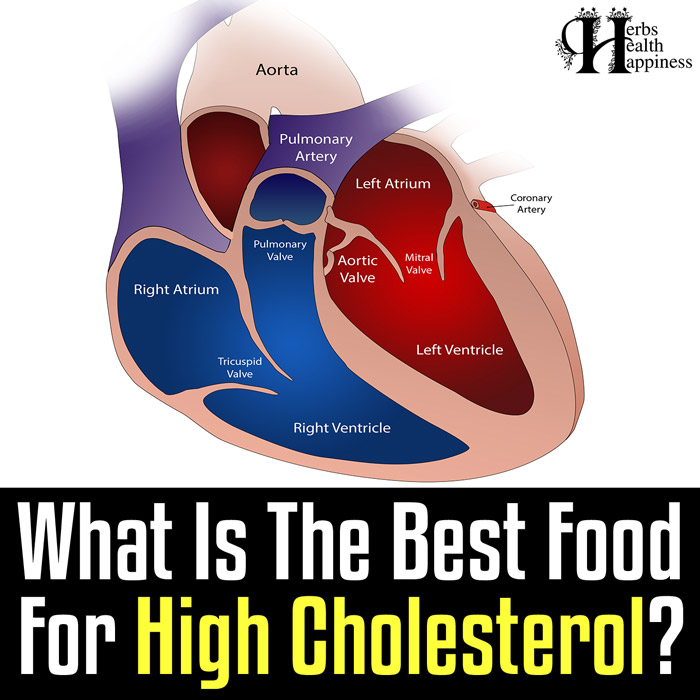
What Is The Best Food For High Cholesterol? Graphic © herbshealthhappiness.com Photo © AdobeStock 31677497 (under license)
The Best Food For Cholesterol Reduction
The Centers for Disease Control and Prevention (CDC) reports that high cholesterol affects over 94 million adults 20 years old and older in the US. [1] A study in 2020 revealed that the prevalence of dyslipidemia was 31.2% in China. [2] According to the World Health Organization (WHO), a third of ischemic heart disease globally is caused by high cholesterol. With the global prevalence of raised cholesterol hitting 39% by 2008, It goes without saying that this a global epidemic. [3]
Understanding Dyslipidemia (High Cholesterol)
When you get your lipid profile taken, there are three readings or results from your blood: LDL or low density lipoprotein, HDL or high density lipoprotein, and trigylcerides. Dyslipidemia is characterized by an imbalance of these lipids, usually a high LDL, low HDL, and high triglyceride. [4]
LDL is known as “bad cholesterol” because it builds up in our arteries and damages them, causing a blockage which can cause a stroke or heart attack. High LDL and triglyceride levels increase your risk for cardiovascular diseases. On the other hand, HDL is “good cholesterol” because it is readily carried to back to your liver to be processed by the body. [5]
When you get diagnosed with dyslipidemia (high cholesterol), some doctors will start you on dietary modifications first before prescribing you with lipid-lowering medication. Others would have you on a regimen of both: lifestyle modification and a prescription drug. However, lipid-lowering medications such as statins (e.g. Atorvastatin, Rosuvastatin) have adverse side-effects such as liver and kidney dysfunction. [6][7] While these side effects are often mild, they have the potential to be quite damaging if your liver and kidneys aren’t working optimally in the first place.
Amla: The Wonder Plant
Amla (Embica officianalis), aka “Indian gooseberry” has been used in Ayurvedic medicine since old times to treat a variety of ailments. [8] It is often dubbed a “wonder plant” because of its high antioxidant content (phenols, tannins, to name a few) and its traditional use in the management of diarrhea, jaundice, inflammation and many other conditions in Ayurvedic medicine.
In 2011, a study using powdered Amla fruit made waves when results showed how it exhibited significant lipid lowering effects similar to, if not better, than prescription drugs. Akhtar, et. al. [9] used powdered Amla fruit, not an extract, on 32 volunteers. 16 were diagnosed diabetics (the experimental group) while the other 16 were age-matched and gender-matched counterparts (the control group). These volunteers were chosen randomly from the outdoor clinics of University of Agriculture and Khadija Memorial Trust Hospital in Pakistan.
The fasting lipid profile results of both groups were compared before and after supplementation with powdered Amla fruit, with different groups receiving 1g, 2g, and 3g respectively. A significant decrease in total cholesterol, triglyceride, and LDL levels and increase in HDL levels were seen in both experimental and control groups after 8, 15, and 21 days. Improvement in lipid profile results were seen later in the diabetic group compared to the control group, but the improvement was still significant compared to their baseline results. The researchers hypothesize that this is due to the high antioxidant content of the Amla fruit, with its anti-inflammatory and free-radical scavenging abilities. This was also seen in older studies on Amla, published in the 1990s, from which Akhtar, et. al. based their research.
With such beneficial results from the get go, Akthar, et. al. concluded that Amla could be used an an alternative therapy in the management of dyslipidemia to lower the economic burden on those affected by high cholesterol, heart disease, and even diabetes, while reducing the risk of adverse effects associated with medication.
An update to Akhtar, et. al’s study was done in 2019, by Updaya, et. al. [10] The researchers used an extract of Amla this time, in a double-blind, placebo-controlled, multicenter clinical trial. There was a total of 98 patients included in the trial and supplementation was done over a period of 12 weeks. The results of the study were spot on with the earlier study in 2011, with the group receiving Amla exhibiting lower total cholesterol, LDL, and triglyceride levels after 12 weeks. Moreover, the researchers also found Amla beneficial in terms of the patients’ AIP or atherogenic index of the plasma, which is an indicator of heart disease risk. The Amla group showed a 39% reduction in AIP, which suggested that Amla had cardioprotective effects as well.
Other Studies On Amla
Researchers have found other important potential benefits of Amla. Baliga and Dsouza in 2011 published a review in the European Journal of Cancer Prevention [11], consolidating the results of various studies done on Amla. The review highlighted the following characteristics of the plant: anti-neoplastic (killing cancer cells) ability, chemomodulatory effects (reducing the adverse effects of chemotherapy on immunity), radioprotection (against radiation therapy), and chemoprevention (prevention of carcinogenesis).
A study published in 2020 by Teimouri, et. al. found that Amla’s significant antioxidant and anti-inflammatory abilities could effectively reduce the risk for Alzheimer’s disease, a condition that until today has no cure. [12] In 2021, researchers focused not on the fruit, but Amla bark, and found that it too was rich in phenols and antioxidant compounds, and used it in a topical gel. The results of the study showed that the topical gel had superior anti-aging efficacy, able to improve skin elasticity and hydration, lighten skin color, and reduce wrinkles. [13]
Studies have now been done worldwide on Amla and its health benefits. A common theme you will see in the results is how these benefits are attributed to the very strong antioxidant capabilities of this plant’s fruit. Not only do the studies report that it can lower cholesterol, but it may also protect other organs in your body such as your heart, skin, and brain. If you want to include Amla in your diet, you can drink it in a tea, take a powdered supplement or even eat the berries fresh. Others even use the powder to make a paste and use on their hair and skin. There are plenty of ways to incorporate this plant into your life.
References:
[1] Centers for Disease Control and Prevention. High cholesterol facts. https://www.cdc.gov/cholesterol/facts.htm
[2] Xi, Y., et. al. (2020). Prevalence of dyslipidemia and associated risk factors among adults aged ≥35 years in northern China: a cross-sectional study. https://pubmed.ncbi.nlm.nih.gov/34765968/
[3] World Health Organization. Raised cholesterol. https://www.who.int/data/gho/indicator-metadata-registry/imr-details/3236
[4] Pappan, N. & Rehman, A. (2021). Dyslipidemia. https://www.ncbi.nlm.nih.gov/books/NBK560891/
[5] Centers for Disease Control and Prevention. LDL and HDL Cholesterol: “Bad” and “Good” Cholesterol. https://www.cdc.gov/cholesterol/ldl_hdl.htm
[6] Andrejak, M., et. al. (2003). Adverse effects of statins. https://pubmed.ncbi.nlm.nih.gov/12822204/
[7] Muscari, A., et. al. (2002). Lipid-lowering drugs: are adverse effects predictable and reversible? https://pubmed.ncbi.nlm.nih.gov/12077562/
[8] Krishnaveni, M. & Mirunalini, S. (2010). Therapeutic potential of Phyllanthus emblica (amla): the ayurvedic wonder. https://pubmed.ncbi.nlm.nih.gov/20506691/
[9] Akhtar, M., et. al. (2010). Effect of Amla fruit (Emblica officinalis Gaertn.) on blood glucose and lipid profile of normal subjects and type 2 diabetic patients. https://www.researchgate.net/publication/51053902_Effect_of_Amla_fruit_Emblica_officinalis_Gaertn_on_blood_glucose_and_lipid_profile_of_normal_subjects_and_type_2_diabetic_patients
[10] Updaya, H., et. al. (2019). A randomized, double blind, placebo controlled, multicenter clinical trial to assess the efficacy and safety of Emblica officinalis extract in patients with dyslipidemia. https://www.ncbi.nlm.nih.gov/pmc/articles/PMC6341673/
[11] Baliga, M. & Dsouza, J. (2011). Amla (Emblica officinalis Gaertn), a wonder berry in the treatment and prevention of cancer. https://journals.lww.com/eurjcancerprev/Fulltext/2011/05000/Amla__Emblica_officinalis_Gaertn_,_a_wonder_berry.11.aspx
[12] Teimouri, E., et. al. (2020) Amla Therapy as a Potential Modulator of Alzheimer’s Disease Risk Factors and Physiological Change. https://pubmed.ncbi.nlm.nih.gov/32083581/
[13] Chaikul, P., et. al. (2021). Phyllanthus emblica L . (amla) branch: A safe and effective ingredient against skin aging. https://pubmed.ncbi.nlm.nih.gov/34522633/
★ Get My Books - 100% FREE:
😳 Tinnitus And Brain Health?
After 47 years of studies and countless brain scans done on more than 2,400 tinnitus patients, scientists at the MIT Institute found that in a shocking 96% of cases, tinnitus was actually shrinking their brain cells.
As it turns out, tinnitus and brain health are strongly linked.
Even more interesting: The reason why top army officials are not deaf after decades of hearing machine guns, bombs going off and helicopter noises…
Is because they are using something called "the wire method", a simple protocol inspired by a classified surgery on deaf people from the 1950s...
★ How To Get Rid Of Nail Fungus:
★ Does Your Salad Contain This Vegetable?
★ 20 Natural Painkillers In Your Kitchen (Video):
★ Men's Prostate Health:

2. Famous Chef Sheds 60lbs Researching New Paleo Recipes: Get The Cookbook FREE Here
3. #1 muscle that eliminates joint and back pain, anxiety and looking fat
4. 7 odd foods that KILL your abdominal fat (surprising fat-fighters)
5. The TRUTH about bread (Will surprise you!)
6. [PROOF] Reverse Diabetes with a "Pancreas Jumpstart"
7. Here's What Happens When You "Unlock Your Hip Flexors"
8. The #1 WORST food that CAUSES Faster Aging (beware -- Are you eating this?)
The #1 Muscle That Eliminates Joint And Back Pain, Anxiety And Looking Fat
By Mike Westerdal CPT
Can you guess which muscle in your body is the #1 muscle that eliminates joint and back pain, anxiety and looking fat?
This is especially important if you spend a significant amount of time sitting every day (I do, and this really affects me in a big way!)
Working this "hidden survival muscle" that most people are simply not training because no-one ever taught them how will boost your body shape, energy levels, immune system, sexual function, strength and athletic performance when unlocked.
If this "hidden" most powerful primal muscle is healthy, we are healthy.
Is it...
a) Abs
b) Chest
c) Glutes
d) Hip Flexors
Take the quiz above and see if you got the correct answer!
P.S. Make sure you check out this page to get to know the 10 simple moves that will bring vitality back into your life:
If you enjoyed this page:














